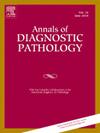硬膜下血肿患者脑膜上皮增生频率及其临床病理相关性的研究
IF 1.4
4区 医学
Q3 PATHOLOGY
引用次数: 0
摘要
硬脑膜下血肿是由于位于硬脑膜和蛛网膜之间的硬脑膜下间隙内的桥静脉出血而形成的。血肿区手术标本的组织病理学检查可显示脑膜上皮细胞增生继发于出血。本研究旨在评估在这些标本中观察到的脑膜上皮增生(MH)的频率、细胞计数和大小,并强调这种可能与脑膜瘤相似的增生在鉴别诊断中的作用。回顾性分析68例硬膜下血肿手术的病理切片。测定MH区膜厚度、增生细胞数和大小。研究了其与临床参数(如年龄、性别、高血压、糖尿病和慢性肾脏疾病)以及组织病理学参数(如肉芽组织和沙粒体)的关系。23例(33.8%)患者出现MH, 45例(66.2%)患者未出现MH。脑膜上皮细胞层数从最少3层到最多15层不等,平均细胞数9.6层。所有患者MH区平均大小为482 μm,平均膜厚为1.8 mm。沙粒小体23例(33.8%),肉芽组织25例(36.8%)。发现MH的存在与年龄增长有关(p = 0.021),但与高血压、糖尿病或慢性肾脏疾病无关。然而,高血压患者的膜厚度增加(p = 0.029)。总之,本研究调查了硬膜下血肿标本中MH的频率,这是一个反应过程,进一步的临床病理研究对于更好地了解脑膜上皮细胞至关重要,脑膜上皮细胞也是脑膜瘤的起源。本文章由计算机程序翻译,如有差异,请以英文原文为准。

Investigation of the frequency of meningothelial hyperplasia and its clinicopathological correlation in patients diagnosed with subdural hematoma
Subdural hematomas develop as a result of hemorrhages in bridging veins located within the subdural space, between the dura mater and arachnoid mater. Histopathological examination of surgical specimens from hematoma regions may reveal meningothelial cell hyperplasia secondary to the hemorrhage. This study aims to evaluate the frequency of meningothelial hyperplasia (MH), cell count and size observed in these specimens and to highlight this proliferation which may mimic meningioma in differential diagnosis. Histopathological slides of 68 patients operated for subdural hematoma were retrospectively analyzed. Membrane thickness and the cell count and size of hyperplasia in areas with MH were measured. Associations with clinical parameters such as age, sex, hypertension, diabetes mellitus, and chronic kidney disease, as well as histopathological parameters like granulation tissue and psammoma bodies were investigated. MH was observed in 23 patients (33.8 %) and absent in 45 patients (66.2 %). The meningothelial cell layer count ranged from a minimum of 3 to a maximum of 15, with an average cell count of 9.6. The average size of the MH areas was 482 μm and the mean membrane thickness across all patients was 1.8 mm. Psammoma bodies were observed in 23 patients (33.8 %) and granulation tissue was seen in 25 patients (36.8 %). The presence of MH was found to be associated with increasing age (p = 0.021) but was unrelated to hypertension, diabetes, or chronic kidney disease. However, increased membrane thickness was observed in patients with hypertension (p = 0.029). In conclusion, this study investigated the frequency of MH which is a reactive process in subdural hematoma specimens and further clinicopathological studies are crucial for better understanding meningothelial cells, which are also the origin of meningiomas.
求助全文
通过发布文献求助,成功后即可免费获取论文全文。
去求助
来源期刊
CiteScore
3.90
自引率
5.00%
发文量
149
审稿时长
26 days
期刊介绍:
A peer-reviewed journal devoted to the publication of articles dealing with traditional morphologic studies using standard diagnostic techniques and stressing clinicopathological correlations and scientific observation of relevance to the daily practice of pathology. Special features include pathologic-radiologic correlations and pathologic-cytologic correlations.

 求助内容:
求助内容: 应助结果提醒方式:
应助结果提醒方式:


